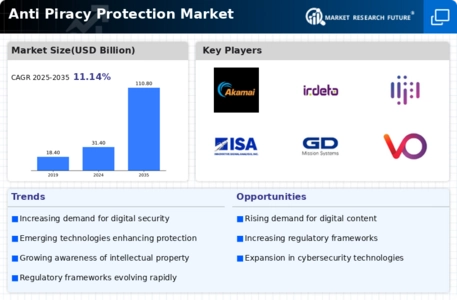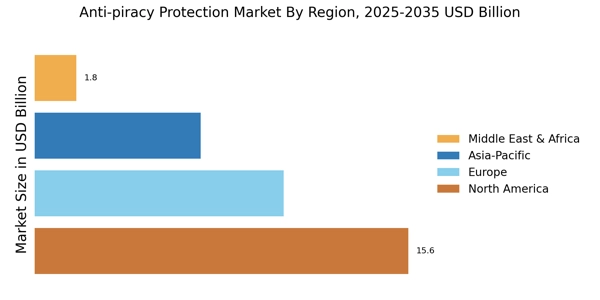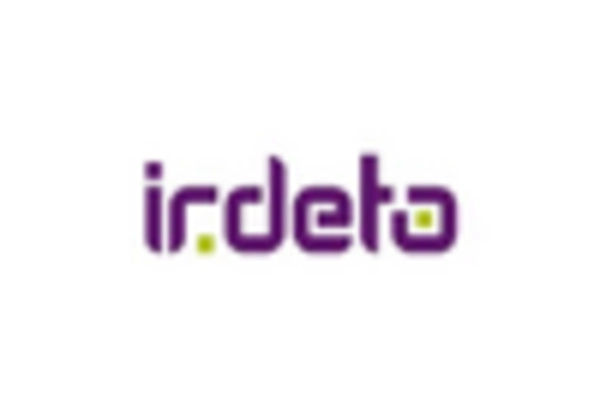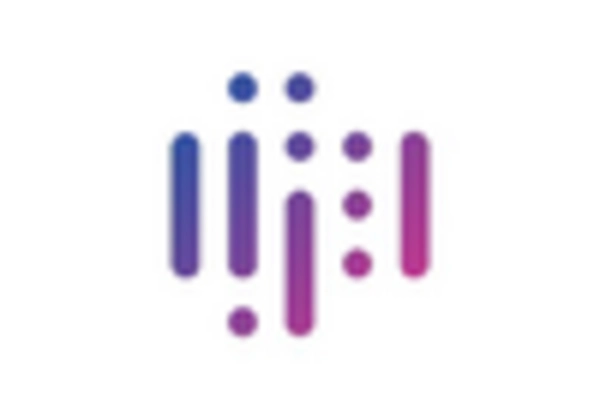Rising Demand for Digital Content
The increasing consumption of digital content across various platforms appears to be a primary driver for the Anti-piracy Protection Market. As more consumers engage with streaming services, e-books, and online gaming, the need for robust anti-piracy measures intensifies. In 2025, the digital content market is projected to reach approximately 300 billion USD, highlighting the potential revenue at stake for content creators. This surge in demand necessitates effective protection strategies to safeguard intellectual property rights, thereby fostering a more secure environment for creators and distributors alike. The Anti-piracy Protection Market is likely to see innovations aimed at addressing these challenges, ensuring that content remains protected against unauthorized access and distribution.
Legislative and Regulatory Frameworks
The evolving legislative landscape surrounding intellectual property rights significantly influences the Anti-piracy Protection Market. Governments worldwide are increasingly enacting stringent laws to combat piracy, which may enhance the demand for anti-piracy solutions. For instance, recent amendments to copyright laws in various jurisdictions have introduced harsher penalties for infringement, thereby incentivizing businesses to invest in protective measures. This regulatory push is expected to drive growth in the anti-piracy sector, as companies seek compliance with these laws to avoid legal repercussions. The Anti-piracy Protection Market could experience a surge in demand for services that ensure adherence to these regulations, ultimately fostering a more secure digital ecosystem.
Expansion of E-commerce and Online Services
The proliferation of e-commerce and online services is a significant driver for the Anti-piracy Protection Market. As businesses increasingly shift to digital platforms, the risk of piracy and unauthorized distribution of products and services escalates. In 2025, the e-commerce sector is anticipated to surpass 5 trillion USD, underscoring the vast market potential that is vulnerable to piracy. This expansion necessitates the implementation of effective anti-piracy measures to protect both digital goods and services. Consequently, the Anti-piracy Protection Market is likely to experience growth as companies seek to secure their online offerings against piracy threats, ensuring the integrity of their digital transactions.
Technological Advancements in Security Solutions
The rapid advancement of technology plays a crucial role in shaping the Anti-piracy Protection Market. Innovations such as blockchain, artificial intelligence, and machine learning are being integrated into anti-piracy solutions, enhancing their effectiveness. For example, AI-driven analytics can identify and mitigate piracy threats in real-time, while blockchain technology offers transparent tracking of digital assets. As these technologies evolve, they are likely to provide more sophisticated tools for content protection, thereby attracting investment in the anti-piracy sector. The Anti-piracy Protection Market is expected to benefit from these advancements, as businesses increasingly seek cutting-edge solutions to combat piracy and protect their intellectual property.
Increased Awareness of Intellectual Property Rights
There appears to be a growing awareness among businesses and consumers regarding the importance of intellectual property rights, which is driving the Anti-piracy Protection Market. Educational initiatives and campaigns aimed at highlighting the consequences of piracy have contributed to this heightened awareness. As stakeholders recognize the value of protecting creative works, there is a corresponding increase in demand for anti-piracy solutions. This trend is likely to encourage companies to invest in protective measures, thereby fostering a more robust anti-piracy ecosystem. The Anti-piracy Protection Market may see a rise in partnerships between content creators and anti-piracy firms, aimed at promoting a culture of respect for intellectual property.


















Leave a Comment